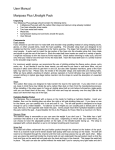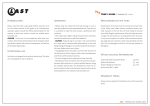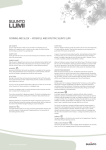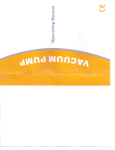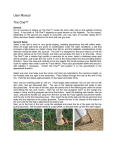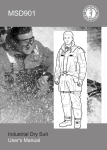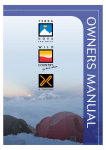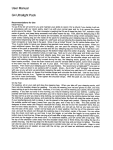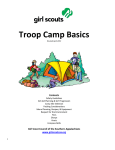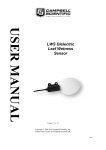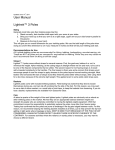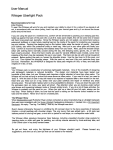Download User Manual Miniposa Ultralight Pack
Transcript
User Manual Miniposa Ultralight Pack Unpacking Your Miniposa package should contain the following items: A Miniposa pack with the carbon fiber stays and sternum strap already installed. Two foam shoulder strap inserts. Two foam waist belt inserts. Compression lacing and cord locks (inside the pack). User Manual Components Foam Inserts If you choose to use the foam for waist belt and shoulder strap padding instead of using sleeping socks, gloves, or other unused items, insert the foam padding. The shoulder strap foam are designed to be installed so that the 'notch' corresponds to the Velcro opening. The larger 'tab' should be installed up for most people. It works well to insert the top portion of the foam into the shoulder strap first, then rotate and squish to get the rest of the foam in. Since the waist belt foam inserts are used for a variety of packs, it might be necessary to trim the insert to fit the waist belt. Check before trimming to make sure, and trim only what you need to have the foam fit into the waist belt. Insert the waist belt foam in a similar manner to the shoulder strap inserts. For maximum weight savings, we recommend the use of clothing articles like fleece socks, gloves, extra socks, etc. If you decide to use the foam inserts, you will want to put them in and leave them, not just because it takes some effort to get them in and out, but also after repeated insertions, parts of the foam tabs may start to tear. Please note, the inside of the shoulder straps and waist belts are wicking fabric. While we have added a backing of silnylon, profuse sweaters in humid climates may want to insert their unused clothing in ziplock type bags before insertion into the straps to avoid the absorption of unwanted moisture. Stays The carbon fiber stays are designed to help transfer the load to the waist belt. If you take them in and out, keep in mind there may initially be some carbon fiber dust on them from the manufacturing process. When installing, if the stays seem to 'hang up' slightly about half an inch before full insertion, jiggle gently until you can insert them all the way. Close the hook and loop tab securely over the stay tube so the stays can't work their way out of the tops. Hydration Bladder Pocket The Miniposa is equipped with a sleeve on the inside for holding a hydration bladder. Insert your bladder, then run the drinking tube out either the right or left side drinking tube port. If you have no use for the sleeve, you can carefully trim it out and save 0.1 oz. The left side pocket is designed to be large enough to carry a water bladder. To balance out the weight you can usually pack a dense part of your load, like food, on the opposite side inside the pack. Some people insert their hydration bladders outside the pack, behind the pad. A good bladder for this is the Platypus 3L Hoser, filled to a maximum of 2 liters. Sternum Strap The sternum strap is removable so you can save the weight if you don't use it. The slider has a 'split' connector that allows it to be removed from the pack. Depending on which side you install where, you can choose to have the adjustable portion on the right, or the whistle buckle facing up. The strap is equipped with a shock absorber so as to not hamper breathing and movement. Compression Lacing The compression lacing is designed to provide some compression for smaller loads. When you receive the pack, the lacing should be inside the pack with the cord locks. You may want to experiment with different configurations. There are matching lash loops on the back of the pack for flexibility. Possible options to try would be lashing across the back and one of the sides to provide additional compression or lacing up each side to reduce the pack volume. Ice Axe Holder To use the ice axe holder, hold the ice axe head up, and put the handle down through the webbing loop. With the head snugly against the loop, bring the handle up against the back of the pack, and use the shock cord or other means to secure it against the pack. 'Y' Top Closure The top closure webbing is designed long, to accommodate a full extension collar, a bear canister, etc. The 'Y' angle can be adjusted by using the slider. For large heavy loads, such as a bear canister, you will need to either put the canister inside a fabric cover with lash attachments on it, or epoxy some lash attachments directly onto the canister. Keep in mind, most canisters on the market will fit inside the pack, so it may make more sense, if you are short on room, to put softer, lighter portions of your load on top of the pack. Recommendations for Use Initial Packing To see if the Miniposa will work for you and to maintain your ability to return it for a refund if you decide it will not, in accordance with our return policy, load it up with your normal gear and try it on around the house and/or around the block. The main concepts in packing the Miniposa are to maintain a high center of gravity, and keep items accessed most often nearer the top. First, stow the sleeping bag in the bottom of the pack. Since the Miniposa seams are not sealed, we recommend using a trash compactor bag, mylar turkey roasting bag, or a Gossamer Gear pack liner (on the inside of the pack) for protecting your sleeping bag and clothes. We recommend dispensing with the weight of a stuff sack and just stowing the sleeping bag directly into the liner in the pack. Packing the sleeping bag on the bottom helps raise the center of gravity. Next pack your clothes, also within the protective liner. Next put in your other gear and finally your food. Comfort is improved by keeping hard objects away from your back, but heavy items are best placed closer to the back to minimize the pull on the shoulders. Next, pack the shoulder straps and waist belt either with clothing items normally unused during the day, like sleeping socks, gloves, etc, or with the foam inserts provided. Then insert your sleeping pad in the pad holders. We recommend a NightLight™ torso pad or a Z-Lite™ pad cut down to six sections (30”) in length, but almost any pad that is 20" wide will work (note – the Z-LIte™ pad “dimples” do compress with use, so you will end up periodically replacing the pad). Before putting the pack on, loosen the shoulder straps and unbuckle the waist belt. Use the haul loop to lift the pack, and put it on. Tighten the waist belt first, securing the pack around your waist/hips where you find it most comfortable. Then tighten the shoulder straps. With the pack on, see how it fits your particular body type and load. Many components of the Miniposa are designed to be removable. For instance, for extremely light loads, you may find that the carbon fiber stays provide minimal benefit, at which point you can just remove them for that trip. The whistle/sternum strap is removable so that if you don't find a need for it, you can save the weight. If you won't need the shock cord compression strap, it can be removed. On the Trail For packing, sit on your pad and stow the sleeping bag. When you take off your sleeping socks, stuff them into the shoulder straps for padding. Note: if you are expecting rain or you sweat heavily, you may want to put your socks in Ziploc bags before inserting them in the shoulder straps. You may be wearing your hat and gloves to start, and may have nothing to put in the waist belt. However, if it is cold, you will be wearing your jacket, which provides padding. If you start out early in the morning, you may be wearing most of your clothes. Loading your clothing pockets with food for the morning will allow you not to have to stop to remove food from your pack. An alternative would be to keep food handy in the Miniposa pockets. When the day warms up and you stop to strip clothing, we recommend putting the clothing below the food, since the clothing is usually less dense, and packing the clothes below the food will raise the center of gravity. If your tarp/tent/ground cloth is damp, it can be placed in the large back pocket. Placing the wet tarp in the outside pocket will keep it away from your dry gear, and it may even dry a little. The hydration pocket on the inside of the pack is designed to carry a hydration bladder, though it can also be used to store maps you don't need yet, reading material, snacks you want to keep accessible, first aid kit, etc. Outlet ports are provided on both sides, so you can use the side that you prefer for the drinking hose. If you don't use hydration bladders, the lower right side pocket is designed to carry a water bottle and be accessible without taking off your pack. Obtaining food or other items out of the bottom right pocket may be more difficult for all but the most limber users, but it still provides a handy ready access for snacks, your Aquamira® water treatment, camera, etc. The upper right side pocket has very little capacity, and it designed to store either flat items like maps and permits, or at least thin items, like an empty water bladder, or “ten essential” items that you want to keep handy. The left pocket can be used for an additional hydration bottle, fuel bottles, a tent/tarp, larger water bottles, wind shell, etc. The shock cord compression strap can be used to fasten a jacket or raingear to the back of the pack To carry an ice axe, use the bottom loop, and swivel the handle up and put it under the shock cord, or lash it to a couple of the lash loops provided. Once your pack is packed, you can get up, fold up your pad, and slip it into the back of the pack. To close the top, pull on the sides of the extension collar like it was the top of a potato chip bag. Fold the outside quarters in towards the middle at a 45-degree angle, then roll the top of the extension collar away from the shoulder straps, just like rolling the top of a potato chip bag. Take the "Y" strap and fasten it over the top of the folded extension collar and fasten. The "Y" strap is designed to help hold additional loads above the top of the pack, such as a super-comfy pad that you have to have, a bear canister, or other similar items. For full loads, the drawstring can just be cinched at the top of the extension collar, and the strap run over the top to keep it from flopping. The drawstring and roll/strap method are designed as "one or the other" closure systems. Fit For the best fit, we recommend loosening the shoulder straps and waist belt each time you take off the pack. When you put the pack on, fasten the waist belt, hike the pack up on your hips, tighten the waist belt then tighten the shoulder straps. This will avoid stressing the pack and help it last longer, and get you the best possible fit each time. Most people find that the best size of pack for them is one that results in the shoulder straps being level or slightly up from the shoulders. To fine tune the fit, try different configurations of shoulder strap foam. Some people have found that using socks inside the shoulder straps gives them a better fit than the foam. Other options including custom trimming the foam, like taking a slice out so it's not so close to your neck. Other people have found that using two pieces of foam, both skinnier than the ones provided with the pack, created a shoulder strap configuration that worked for them. Care Your Miniposa pack is constructed of lightweight materials. One of the tradeoffs of designing with extremely lightweight materials is durability. The design and materials have been tested over hundreds of trail miles, but your Miniposa pack requires a higher standard of care than other packs. The Miniposa will not last as long or endure the same abuse as other packs. If you want it to last, you need to ‘baby’ it. With the best of care it may still need to be repaired or replaced after a few months on the trail. Each time you head out on a trip, check over your pack carefully and repair or reinforce any areas showing wear. The ripstop nylon is very susceptible to abrasion. If you put down the pack with the ripstop nylon on rocks, your pack will shred. Pay attention when you are ducking under barbed wire fences and squeezing between rocks or through prickly brush. If you do a lot of these activities, the Miniposa is probably not the pack for you. When you pick up or take off your full pack, always use the haul loop. When setting it down, be sure that the pack is resting on the heavier oxford material on the back and the bottom. Never sit or rest on a loaded pack. When carrying a bear canister, be sure to pack an article of clothing around the canister, so the pack won't be damaged by wearing directly against the canister. Note: Recently we’ve had a few reports of the pad holder mesh causing stains on shirts. Last year we encountered this issue in less than 1% of the packs sold and have always thought that it had something to do with specific personal body chemistry which reacts with the dye in the mesh. We have been notified of several more staining issues this season so we have looked into the production of the mesh and have been assured that the fabric is colorfast. We are currently searching for either an alternative fabric or mesh that has been through a more rigorous wash test for the next run of packs. We are also considering a redesign of the back panel that we may test later in the year. In the interim, the best solution is to soak the pack in warm/hot water which should leach out any excess dye in the fabric. Do not put the pack in a washing machine, however. Personal Customizing/User Tips There are several things you may want to consider to personalize your pack. For more rainy climes, you might consider seam-sealing the inside seams. Either McNett SilNet can be purchased, or use a 50/50 mixture of silicon caulking and white gas, and paint it on. If your hiking clothes don’t have a lot of pockets, you could order some lycra mesh and sew small pockets onto the shoulder or waist straps to carry small items that you want to have handy. To save weight, you may want to trim the waist belt to size. Be sure to take into account that you may be wearing additional layers, and don’t cut it too short. After cutting, seal the end with a flame, and sew back over on itself to prevent it from slipping through the buckle. Also in the interest of minimizing weight, you are encouraged to trim off straps you don’t use. Be sure to check the User Tips section on the Gossamer Gear website for suggestions by other users. Design Insights The goal of this section is to give you insights as to the various design features of the Miniposa pack. It may not exactly suit the way you backpack, but may give you ideas, or at least answer some questions you have about the various aspects of the pack. Employing "dual use" technology obviously figured highly in the design of the Miniposa. Weight is minimized by using your sleeping pad as a "frame", and unused socks and clothing as padding for the shoulder straps and waist belt and a sternum strap that doubles as your emergency whistle. Designing the pad to be on the outside of the pack allows you to be sitting on it in the cold morning as you are packing up, as it can be the last thing you pack. It also permits easy removal during the day for sitting on during rest stops, or lying on for naps, as you wait for your more heavily-laden friends to catch up. The use of 210 denier double wall ripstop is reserved for areas having stress concentrations or needing abrasion resistance. The remaining areas of the pack are made out of silicone-coated 1.3 oz. ripstop nylon to save weight. The bottom portion of the pack is covered with relatively durable pocket mesh, to provide additional protection. The Miniposa was designed to reduce the volume of the pack for ultralight backpackers who have reduced their gear to lower levels than most. The Miniposa has 20% less volume than the Mariposa Standard and the Mariposa Plus. The Mini retains all the great features of the other two packs such as the asymmetrical side pockets giving users a large pocket to drop things into without having to worry about them falling out while adding the benefit of having a small pocket so water bottle users could easily pull out their bottles without taking off their packs or imposing upon their friends. The flat pocket was added to provide additional organization options and a consistent level of protection for the pack body. As with the other packs in the Mariposa series, the "Y" strap was designed to help handle the unfortunate but necessary situation of having to carry a bear canister in some popular areas. It also is handy for carrying rolled pads, as the "Y" provides three points of contact for stability. So get out there, and enjoy the lightness of your Miniposa pack! Please forward any suggestions, and send us any user tips that can be added to the website. Rev. August 20, 2007




